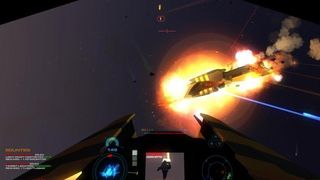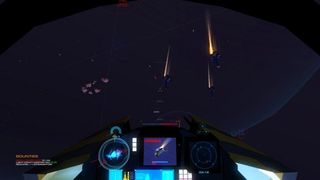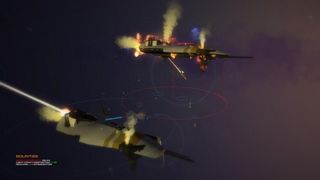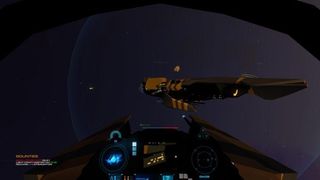Enemy Starfighter hands-on: A shootout in space

I'm going to need a bigger fleet. After spending some time with a recent build of Marauder Interactive's upcoming space-combat sim Enemy Starfighter , two aspects of designer Mike Tipul's game stand out immediately—its responsive controls and the knack its core features have for creating compelling encounters in deep space. Even when I die, and I die a lot, I want to rejoin the fight and try again. In the desolate universe of ES, the kind of armada I pull together becomes a part of the story I get to tell myself.
Players start each new game in ES's basic ship, a light and nimble craft called the interceptor. It's a fragile way to fly, but players have effective control over the ship's speed, roll, and direction, allowing for precise maneuvers if a pilot has the chops to pull it off. The loadout for each interceptor—from top speed, to shield strength, to weapon variety—depends on which political faction you join, but the fundamental accessibility of the control scheme meant I was able to learn quickly. It's important to point out that while ES can be played with either a gamepad or mouse and keyboard, I found my Xbox 360 controller to be the most intuitive way to fly. The game is also being designed to support the Oculus Rift, although I haven't tried it in VR.
The way ES visually represents its take on space-based mayhem and imperial expansion fits neatly with its straightforward approach to flying. The game's smooth, painterly style reminds me of classic sci-fi illustrators such as John Harris , but it still communicates enough information to make accurate flying and shooting possible. As it's currently designed, the HUD is basic, but gives pilots data on nearby enemies and makes it easy to orient the interceptor in relation to my objectives. When commanding a larger armada of capital ships, I can pause the game at any time and give them targets and other tactical orders. My fellow interceptors can be controlled in real-time via the gamepad, and by default fly in formation alongside me.
Enemy Starfighter also dares me to be brave.
Each new level in ES's solitary—for the moment at least—Last Stand game mode offers pilots a choice between very different sets of targets. A bounty system gives you tasks that will yield a new interceptor or two for the armada—essentially extending your chances of staying in the fight—while another target promises a bigger reward in the form of a capital-class destroyer or battleship. It's a choice pilots have to make and commit to at the outset of a battle, since each bounty has a time limit.This decision carries even more weight since once your last interceptor is destroyed, you have to restart the level. But after a group of objectives is complete, it's on to the next battle.

There are currently two factions to choose from when beginning a new game of Last Stand: House Njall and House Styrkarr. I was immediately drawn to the House Njall lineage. A dying faction inside the timeline of ES, it has the fastest ships and weapons that fit my mood—a scatter gun built for space and giant, unwieldy, capital-ship-killing bombs.
Beam frigates, battleships, and destroyers warp to your location if you complete some of the objective-based bounties. The bigger the target, the bigger the reward, with larger and more plentiful ships ready to warp in as you advance through Last Stand. This is how you build your fleet. You win. As your armada grows, you gain additional tactical options. Just like the smaller interceptors, the larger ships flank you automatically and can be assigned specific targets by pausing the game.
The biggest gaming news, reviews and hardware deals
Keep up to date with the most important stories and the best deals, as picked by the PC Gamer team.
But the more levels you complete, the more menacing and powerful the enemy ships become. You need a destroyer or two in order to tilt the odds of survival in your favor. Adding capital ships to your fleet isn't easy, but right now it looks like they're essential in order to progress through Last Stand. Want a beam frigate and its heavy weapons to back you up on your next mission? You have to earn it.

Each fleet's interceptor comes with the same basic weapon, a rapid fire cannon that's best used on other light spacecraft at medium range. The secondary and heavy weapons are where each faction exerts some personality. The wealthier House Styrkarr gives its pilots access to lock-on missiles and a slow—but punishing—heavy cannon in place of the unguided bombs of House Njall.
Since that Tipul calls Last Stand a "testing ground for campaign features such as the bounty system and fleet movement," I'd say he's heading in the right direction in terms of ES's storytelling potential. The more a faction's background shows up in game systems and weapon diversity, the better. This is one area that deserves more development, in order to add meaning and narrative to the already finely-tuned experience of piloting the interceptor. The faction system is good for drawing me into the game, but I want to know more. The once-prosperous House Njall is dying out, but I don't know why, for example.
Given the thoughtfulness that's already so apparent in the game's design, I'm hopeful the backstory will get some more attention. The way the campaign plays out will determine where ES sits in relation to some other upcoming space sims with more galactic-sized ambitions. For ES, I think depth beats breadth and story beats sheer scale. Tipul has also stressed that his goal for ES is that it “really wants to be a short(ish)-form game.”
“I think some people see a space game and immediately launch into 10-plus hour space-opera expectations—even I constantly fight that urge myself,” Tipul says.

Time investment aside, Tipul's game is hard. There's no denying that. In the build I played, every death forces a restart of that level. Because of this, finding the right strategy after several failed attempts can be puzzling—but in a good way. Each death and restart yields information about the capabilities of enemy ships. I measure each bounty on offer against my skills as pilot. By being a better and more thoughtful pilot I get to see where my skills can take me. I want to destroy the biggest capital ships around and organize a skilled armada to pull it off. If you have the skill, Enemy Starfighter gives you the chance.
As for when the game will make its way into the hands of interested pilots, Tipul told me he's planning to make an Early Access version available “later this summer,” with the following caveat: “If I don't think I can deliver something that people will have at least a couple hours of fun playing, I will push it back.”
Most Popular







